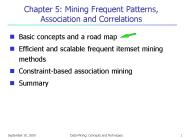Fpgrowth PowerPoint PPT Presentations
All Time
Recommended
Construct conditional tree C within conditional tree E ... Use frequent (k 1)-itemsets (Lk-1) to generate candidates of frequent k-itemsets Ck ...
| PowerPoint PPT presentation | free to view
confidence: count( AB ) / count(A ) Confident: = minimum confidence. Input: a set of transactions. find all frequent patterns AB and A. 3 ...
| PowerPoint PPT presentation | free to download
Applications of BFS and DFS: the Apriori and FPGrowth Algorithms Modified from Slides of Stanford CS345A and UIUC CS412 Jianlin Feng School of Software
| PowerPoint PPT presentation | free to view
nonordfp: An FP-growth variation without rebuilding the FP-tree ... Nodes are placed in an array contiguously. no dynamic allocation. no pointers (just indices) ...
| PowerPoint PPT presentation | free to view
... cond_table = conditional_table_construct(); // construct a conditional ... Combine these tree (sum up) when mining finished. 16. Conclusion ...
| PowerPoint PPT presentation | free to view
Example: Minimal: quarter, then 4 quarters 1 hour, 24 hours day, ... second, minute, quarter, hour, day, week, ... Targeted items ...
| PowerPoint PPT presentation | free to view
LCM: na efficient algorithm for enumerating frequent closed item sets T. Uno, T. Asai, H. Arimura Apresenta o: Luiz Henrique Longhi Rossi Apresenta o Ser o ...
| PowerPoint PPT presentation | free to view
Mining Frequent Patterns Using FP-Growth Method Ivan Tanasi (itanasic@gmail.com) Department of Computer Engineering and Computer Science, School of Electrical ...
| PowerPoint PPT presentation | free to download
Data Mining: Concepts and Techniques (2nd ed.) Chapter 5 Frequent Pattern Mining * *
| PowerPoint PPT presentation | free to view
A Grid-Based Middleware for Scalable Processing of Remote Data Leonid Glimcher Advisor: Gagan Agrawal
| PowerPoint PPT presentation | free to download
MAIDS: Mining Alarming Incidents. in Data Streams. A discussion on the MAIDS project ... TID Items bought (ordered) frequent items. 100 {f, a, c, d, g, i, m, p} ...
| PowerPoint PPT presentation | free to view
Data Mining and Big Data Ahmed K. Ezzat, Data Mining Concepts and Techniques*
| PowerPoint PPT presentation | free to view
Discriminative Analysis. Learning a function of its inputs to base its decision on ... Discriminative Classifiers vs. Bayesian Classifiers. Advantages ...
| PowerPoint PPT presentation | free to download
Efficient and scalable frequent itemset mining methods. Mining various kinds of ... Pattern analysis in spatiotemporal, multimedia, time-series, and stream data ...
| PowerPoint PPT presentation | free to view
Business Data Mining Dr. Yukun Bao School of Management, HUST 10000 ...
| PowerPoint PPT presentation | free to view
What Is Frequent Pattern Analysis? Frequent pattern: a pattern (a set of items, subsequences, substructures, etc.) that occurs frequently in a data set
| PowerPoint PPT presentation | free to view
Computer architecture and compiler research has primarily focused ... Defragmented heap. Reduced inter-object padding. Segregating the heap! Miss rate measured ...
| PowerPoint PPT presentation | free to download
1 Institute of Artificial Intelligence, Zhejiang ... 3 Department of Computer Science, UIUC, USA. 4 Dept. of CS, Hangzhou University of Commerce, China ...
| PowerPoint PPT presentation | free to download
Frequent pattern: a pattern (a set of ... Exercise. DB = { a1, ..., a100 , a1, ..., a50 } Min_sup = 1. ... Example: check abcd instead of ab, ac, ..., etc. ...
| PowerPoint PPT presentation | free to download
Distributed computing in D2K is referred to as Proximities. ... Luigi Marini. Robert McGrath. Chris Navarro. Greg Pape. Barry Sanders. Andrew Shirk. David Tcheng ...
| PowerPoint PPT presentation | free to view
Title: No Slide Title Author: Marilyn Turnamian Last modified by: Vicky Created Date: 11/15/1999 4:56:55 PM Document presentation format: On-screen Show (4:3)
| PowerPoint PPT presentation | free to view
... cross-marketing, catalog design, sale campaign analysis, Web ... Interior node ... Improving Apriori: general ideas. Reduce passes of transaction ...
| PowerPoint PPT presentation | free to view
Multimodal Information Access and Synthesis Research Review Dan Roth Department of Computer Science University of Illinois at Urbana/Champaign
| PowerPoint PPT presentation | free to view
Toon Calders Why Data mining? Explosive Growth of Data: from terabytes to petabytes Data collection and data availability Major sources of abundant data Why Data mining?
























